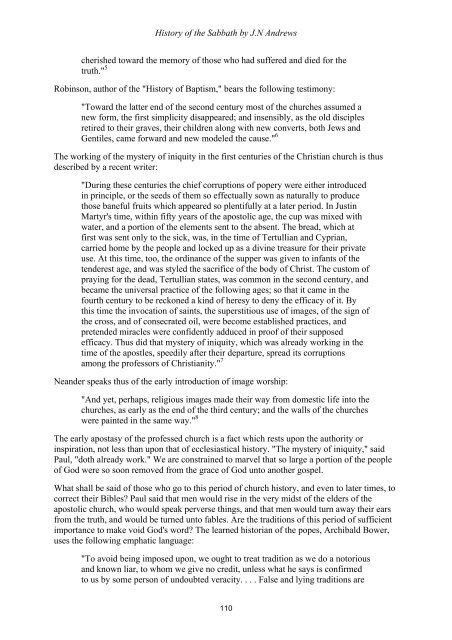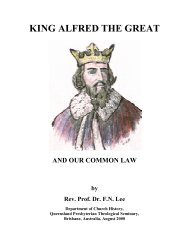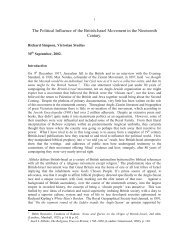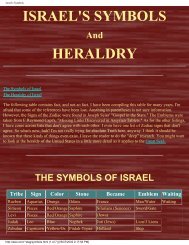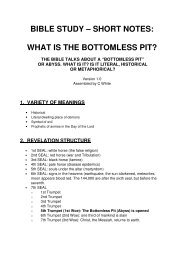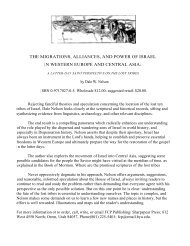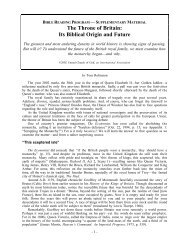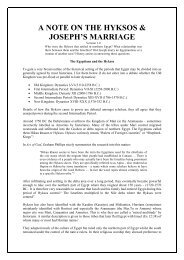HISTORY OF THE SABBATH - Friends of the Sabbath Australia
HISTORY OF THE SABBATH - Friends of the Sabbath Australia
HISTORY OF THE SABBATH - Friends of the Sabbath Australia
Create successful ePaper yourself
Turn your PDF publications into a flip-book with our unique Google optimized e-Paper software.
History <strong>of</strong> <strong>the</strong> <strong>Sabbath</strong> by J.N Andrewscherished toward <strong>the</strong> memory <strong>of</strong> those who had suffered and died for <strong>the</strong>truth." 5Robinson, author <strong>of</strong> <strong>the</strong> "History <strong>of</strong> Baptism," bears <strong>the</strong> following testimony:"Toward <strong>the</strong> latter end <strong>of</strong> <strong>the</strong> second century most <strong>of</strong> <strong>the</strong> churches assumed anew form, <strong>the</strong> first simplicity disappeared; and insensibly, as <strong>the</strong> old disciplesretired to <strong>the</strong>ir graves, <strong>the</strong>ir children along with new converts, both Jews andGentiles, came forward and new modeled <strong>the</strong> cause." 6The working <strong>of</strong> <strong>the</strong> mystery <strong>of</strong> iniquity in <strong>the</strong> first centuries <strong>of</strong> <strong>the</strong> Christian church is thusdescribed by a recent writer:"During <strong>the</strong>se centuries <strong>the</strong> chief corruptions <strong>of</strong> popery were ei<strong>the</strong>r introducedin principle, or <strong>the</strong> seeds <strong>of</strong> <strong>the</strong>m so effectually sown as naturally to producethose baneful fruits which appeared so plentifully at a later period. In JustinMartyr's time, within fifty years <strong>of</strong> <strong>the</strong> apostolic age, <strong>the</strong> cup was mixed withwater, and a portion <strong>of</strong> <strong>the</strong> elements sent to <strong>the</strong> absent. The bread, which atfirst was sent only to <strong>the</strong> sick, was, in <strong>the</strong> time <strong>of</strong> Tertullian and Cyprian,carried home by <strong>the</strong> people and locked up as a divine treasure for <strong>the</strong>ir privateuse. At this time, too, <strong>the</strong> ordinance <strong>of</strong> <strong>the</strong> supper was given to infants <strong>of</strong> <strong>the</strong>tenderest age, and was styled <strong>the</strong> sacrifice <strong>of</strong> <strong>the</strong> body <strong>of</strong> Christ. The custom <strong>of</strong>praying for <strong>the</strong> dead, Tertullian states, was common in <strong>the</strong> second century, andbecame <strong>the</strong> universal practice <strong>of</strong> <strong>the</strong> following ages; so that it came in <strong>the</strong>fourth century to be reckoned a kind <strong>of</strong> heresy to deny <strong>the</strong> efficacy <strong>of</strong> it. Bythis time <strong>the</strong> invocation <strong>of</strong> saints, <strong>the</strong> superstitious use <strong>of</strong> images, <strong>of</strong> <strong>the</strong> sign <strong>of</strong><strong>the</strong> cross, and <strong>of</strong> consecrated oil, were become established practices, andpretended miracles were confidently adduced in pro<strong>of</strong> <strong>of</strong> <strong>the</strong>ir supposedefficacy. Thus did that mystery <strong>of</strong> iniquity, which was already working in <strong>the</strong>time <strong>of</strong> <strong>the</strong> apostles, speedily after <strong>the</strong>ir departure, spread its corruptionsamong <strong>the</strong> pr<strong>of</strong>essors <strong>of</strong> Christianity." 7Neander speaks thus <strong>of</strong> <strong>the</strong> early introduction <strong>of</strong> image worship:"And yet, perhaps, religious images made <strong>the</strong>ir way from domestic life into <strong>the</strong>churches, as early as <strong>the</strong> end <strong>of</strong> <strong>the</strong> third century; and <strong>the</strong> walls <strong>of</strong> <strong>the</strong> churcheswere painted in <strong>the</strong> same way." 8The early apostasy <strong>of</strong> <strong>the</strong> pr<strong>of</strong>essed church is a fact which rests upon <strong>the</strong> authority orinspiration, not less than upon that <strong>of</strong> ecclesiastical history. "The mystery <strong>of</strong> iniquity," saidPaul, "doth already work." We are constrained to marvel that so large a portion <strong>of</strong> <strong>the</strong> people<strong>of</strong> God were so soon removed from <strong>the</strong> grace <strong>of</strong> God unto ano<strong>the</strong>r gospel.What shall be said <strong>of</strong> those who go to this period <strong>of</strong> church history, and even to later times, tocorrect <strong>the</strong>ir Bibles? Paul said that men would rise in <strong>the</strong> very midst <strong>of</strong> <strong>the</strong> elders <strong>of</strong> <strong>the</strong>apostolic church, who would speak perverse things, and that men would turn away <strong>the</strong>ir earsfrom <strong>the</strong> truth, and would be turned unto fables. Are <strong>the</strong> traditions <strong>of</strong> this period <strong>of</strong> sufficientimportance to make void God's word? The learned historian <strong>of</strong> <strong>the</strong> popes, Archibald Bower,uses <strong>the</strong> following emphatic language:"To avoid being imposed upon, we ought to treat tradition as we do a notoriousand known liar, to whom we give no credit, unless what he says is confirmedto us by some person <strong>of</strong> undoubted veracity. . . . False and lying traditions are110


